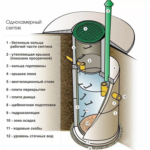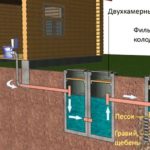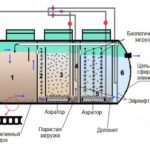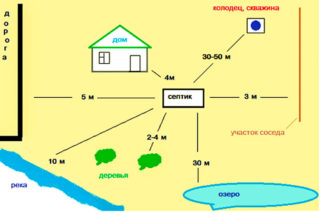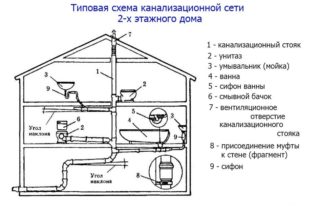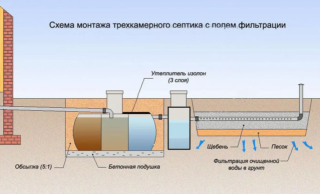The key to a comfortable stay in a private house is the availability of all the necessary communications, and in particular the sewerage system. With certain knowledge and skills, it is not difficult to cope with the laying of the collector. The sewerage device in a private house with their own hands is divided into two stages of work - external and internal.
Types of sewer systems for a private house
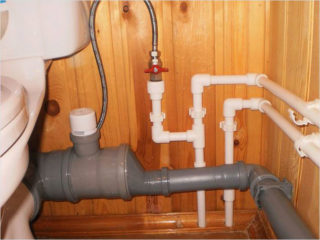
Taking into account the fact that the pipeline will not be connected to the city central highway, the owners of private plots are constructing one of the types of sewerage systems near their home:
- A single-chamber septic tank is a cesspool with a sealed bottom and walls. Provided that the tank is completely filled, it is necessary to pump out sewage using a sewage system. It is possible to make a drainage / filtering bottom at a single-chamber septic tank. So the water will go into the ground. But here you should be careful: if the groundwater level is high on the site, there is a risk of contaminating nearby drinking wells. Such actions are punishable by law.
- Two-chamber septic tank. Represents two adjacent tanks. The first has a larger volume than the second. The sewage flows down the collector to the main receiver, where it settles. Large particles of debris (feces, paper) settle to the bottom. Clarified water is poured into a second reservoir and drains into the ground there. The bottom of the second accumulator is made of sand and crushed stone. To avoid silting it up, it is better to change the filling every 4-5 years. The first tank is cleaned every 1-2 years.
- Septic tank for biological treatment. Here, bacterial preparations are used to process sewage into organic matter - sludge and water. Such a reservoir must be connected to electricity, since bacteria work only in a positive temperature condition.
Regardless of whether the master wants to make a sewer with a cesspool or wants to equip a full-fledged septic tank, it is necessary to pull a pipeline from the house to any of the types of tanks.
Current requirements for sewerage in a private house
- A sewage receiver (septic tank) is located in the lower part of the site, no closer than 5 m to a country house and other residential building.
- From the garden / vegetable garden, you need to remove the sewer at least 10 m.
- The reservoir is located at a distance of at least 20 m from wells and other sources with water.
- The inner and outer pipes of the collector are laid with a slope. It varies depending on the diameter of the communication. The smaller the tube section, the greater the slope. For pipes of 110 mm, you need to adhere to the value of 5-7 mm per 1 running meter of the collector. The inner tubes are laid with a minimum slope of 2.5 cm for each m of the system. Ideally 3.5 cm per meter.
- The external pipeline is deepened below the level of soil freezing. If this is not possible, it is well insulated. Otherwise, the sewage will freeze in the system.
- It is advisable to avoid sharp turns / rises / bends of the manifold.
- For laying the internal sewerage, pipes with a cross section of 50 mm are used. The installation of tubes with a diameter of 110 mm is brought to the toilet. The cross-section of the external pipeline varies depending on the expected volume of effluent. For a family of 3-5 people, a diameter of 110-160 mm is sufficient.If the sewer system serves several objects, then the outer pipes are taken with a diameter of 200 mm or more.
When arranging an autonomous sewage system with your own hands, you should be guided by SNiP 2.04.03-85 “Sewerage. External networks and facilities ". Storm water is not discharged into a septic tank. A separate receiver is mounted under them.
Designing and carrying out the necessary calculations
It is imperative that all bends, joints, branches and turns of the manifold be marked on the drawing. So the master will be able to purchase the required number of adapters, fittings, etc.
The volume of the septic tank is calculated according to SNiP. According to sanitary standards, there are 200 liters of effluent per person per day. For a family of three, the volume of the septic tank / pit should be 6 cubic meters.
Choice of materials
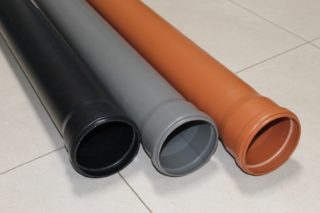
For the correct laying of the sewage system in a private house with your own hands, it is important to choose a reliable collector material. Usually they use plastic and cast iron pipes. The metal is good for laying the outside of the system. It is durable, wear-resistant, inert to aggressive media and temperature extremes. However, cast-iron pipes cannot be laid without the help of a neighbor or special equipment. They cost significantly more than polymer ones.
Plastic pipes made of PVC or HDPE have proven themselves well in the device of private sewerage. The second option is especially suitable for laying the outside of the manifold. Polymer pipes have a number of positive properties:
- Favorable cost of materials and lightness. You can work with the polymer yourself.
- Inertness of plastic to temperature extremes and aggressive media.
- Perfect smoothness of the inner walls of the pipes. The drains move along them without delay and noise.
- Tendency to linear stretch and tensile strength.
The pipes for the outside of the system have a corrugated surface. The rings are in the form of stiffening ribs, so the pipeline is not threatened with deformation under the influence of heaving of the soil.
Installation steps
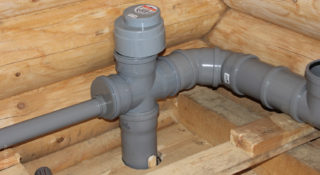
You need to install a home sewage system from the inside of it. In all rooms with plumbing equipment (kitchen, bathroom, pool, sauna), pipes are installed towards the riser. The wiring is made from tubes with a diameter of 50 mm. A pipe with a cross section of 110 mm is connected to the toilet.
All joints, connections must be treated with a sealant. Plugs are installed at the outlets for household washing appliances.
The riser is brought to the foundation, in which a hole with a diameter of 130-160 mm is pre-punched. A metal sleeve must be inserted into it. Through it, the collector pipe is brought out. The outlet of the outer pipe is insulated with high quality, the gaps between the sleeve and the foundation are concreted.
The inside of the sewer can be laid in a hidden and open way. In the first case, special strobes are made in the walls and floor and then the communication is closed with decorative trim. In the open method of installation, clamps are used as fasteners for pipes.
External sewerage
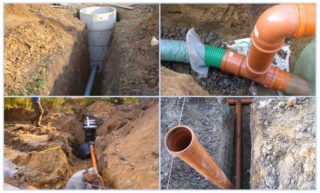
Initially, you will have to dig trenches for the collector. They are dug from the very exit of the pipe from the house and up to the intended location of the septic tank. The depth of digging depends on the level of freezing of the soil in the region, as a rule, it is at least 70-90 cm.The top edge of the laid pipe should be at this mark from the ground surface.
In the course of digging trenches, the slope set by SNiP is observed. The final sink for drains should be located below the outlet of the sewer pipe from the house. Then they work like this:
- A sand cushion is poured at the bottom of the trenches and tamped well.
- Pipes are laid on the base, connecting them securely.
- The fully assembled system is checked for leaks. If there are no leaks, water leaves the house freely, you can backfill the collector. At the same time, the soil is not strongly rammed. He will sit down himself over time. If necessary, then add more earth from above.
Plastic pipes are not laid in areas with a high load (roadway, etc.), or they are mounted in a special corrugated / metal sleeve.
Septic tank device
- Pits are dug under the tanks in accordance with the parameters of the barrels. In this case, the depth and width of the pit are increased by 30-40 cm under the base and backfill.
- The bottom of the pit is carefully rammed. Pour a sandy pad of moistened sand. It is well compacted.
- A wooden formwork is placed on the sand under the first chamber and a concrete solution 20-30 cm thick is poured.
- The bottom of the second tank is made drainage. A layer of fine gravel is poured onto a sand pillow, and on top - broken brick or cobblestone.
- After the solution has dried, place both tanks next to each other. It is important that there are no distortions.
- Both chambers are connected by an overflow pipe at a level of 40 cm from the bottom of the barrels.
- A drain / waste pipe is brought to the first receiver in its upper part. All joints are well sealed.
- The reservoirs are filled with water and only after that they are backfilled with careful compaction of the soil. If the barrels are not filled with water, they can burst in the soil later.
- The top of the septic tank chambers are covered with hatches.
It is strictly forbidden to mount a septic tank with a filtering bottom in swampy areas. Only a sealed receiver or aeration tank is suitable here.

